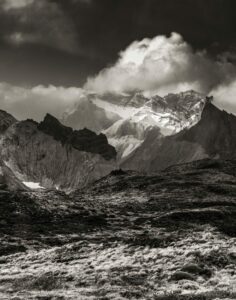- Photography Process
- Portrait Photography
- Commercial Photography
- Product Photography
- Fine Art Photography
- Editorial Photography
- Conceptual Photography
- Stock Photography
- Soft Focus Photography
- How To Shoot Film Photography
- Short Lighting Photography
- Split Lighting Photography
- Side Lighting In Photography
- Creative Photography Ideas
- 200+ More Photography Guides
Straight photography is a movement that champions sharply focused and detailed images, capturing the world as it truly is.
It’s a style that shuns manipulation, letting the subject’s raw beauty speak for itself.
We’ll explore the origins, characteristics, and influential figures of this authentic approach to photography.
Get ready to understand how straight photography became a pivotal moment in the art world, influencing generations of visual storytelling.
Origins Of Straight Photography
Straight photography emerged as an art form at the beginning of the 20th century, standing in bold contrast to the pictorialist style that dominated the late 19th century.
Pictorialists often used soft focus and manipulation to create images that resembled paintings or etchings.
In contrast, straight photographers sought to separate photography from traditional art forms, championing the camera’s unique ability to capture the world as it is.
Alfred Stieglitz played a pivotal role in propelling straight photography into the limelight.
With the founding of the Photo-Secession group in 1902 and later Camera Work magazine, Stieglitz and his contemporaries began to challenge the status quo.
They focused on the sharpness of lens work, which was radical for its time.
At its core, the movement was about:
- Honesty in representation – Technical mastery of the camera,
- An emphasis on photographic composition.
Paul Strand’s Wall Street, New York is often cited as a defining piece that epitomized the ethos of straight photography.
Taken in 1915, this photograph showcased clean lines, geometric forms, and deep focus which became hallmarks of the movement.
Strand insisted on the need for photographs to have their own visual language, distinct and direct, much like the reality they captured.
As enthusiasts and educators in the creative domain, we understand the importance of recognizing groundbreaking shifts in visual arts.
Straight photography was one such shift – it wasn’t just about the aesthetic; it represented a philosophy that the photographic medium should not imitate other art forms but stand on its own, a testament to the truth.
Characteristics Of Straight Photography
Straight photography signifies a movement towards capturing the world authentically through the lens.
It’s driven by key attributes that we recognize as the backbone of this compelling approach to photography.
The aesthetic of straight photography is starkly different from the manipulated images of previous trends.
It’s based on a clear set of principles that guide photographers in their work.
We can identify several characteristics central to this style:
- Unmanipulated images – The photographs are often untouched by editing techniques that alter reality.
- Sharp focus – A depth of field that renders subjects crisp and detailed is characteristic of this style.
- Simple composition – Instead of cluttered or manipulated scenes, the composition in straight photography leans towards simplicity and straightforwardness. Our adherence to technical precision is evident in the way straight photography champions the use of the camera’s full potential. Mastery of the camera settings and understanding the interplay of light and shadow are critical. This mastery allows photographers to create images that are technically flawless and faithfully represent their subjects.
Straight photography also represents a certain purity in capturing life’s moments.
The raw and unembellished portrayal in images like Paul Strand’s Wall Street, New York highlights the movement’s philosophy.
We see the urban landscape exactly as it is – bustling, geometric, and full of energy.
In our exploration of this discipline, it’s clear that straight photography isn’t just about technique – it’s also an artistic choice.
Choosing to capture the essence of the world without embellishment speaks to a photographer’s approach to authenticity.
The guiding principles of this style form a framework that has influenced not only photographers but also the broader realm of visual arts.
Each photograph taken in this manner stands as a testament to the artist’s commitment to realism.
As we continue to explore the nuances of straight photography, it’s remarkable how this style remains relevant in modern digital era, where the allure of filters and photo manipulation is ever-present.
Straight photography reminds us that there’s power in purity and that sometimes the most profound statements are made with the simplest of expressions.
Influential Figures In Straight Photography
Straight photography has been shaped by a number of iconic artists, each bringing their own unique vision to the realism movement.
Their contributions have been instrumental in defining the parameters and aesthetics of this genre.
One of the most prominent figures is Alfred Stieglitz, whose work in The Steerage is often hailed as a seminal piece in straight photography.
His dedication to the art played a pivotal role in establishing photography as a form of fine art.
Stieglitz’s gallery, 291, became a hub for straight photographers and other modern artists.
Equally influential was Paul Strand, whose abstraction and candid street scenes adhered strictly to the principles of straight photography.
His move towards simplicity and directness in pieces like Wall Street conveyed the power of everyday subjects.
Other notable photographers in this movement include:
- Edward Weston – known for his meticulously composed still lifes and landscapes,
- Ansel Adams – whose legendary landscapes emphasized the grandeur of nature without embellishment,
- Imogen Cunningham – celebrated for her botanical photographs and nudes, showcasing organic forms with clarity.
These individuals did not merely capture reality but channeled it through their lenses, each with a distinct style that bolstered the philosophy of straight photography.
Collectively, they set a benchmark for following generations, demonstrating the raw power of capturing moments without manipulation.
https://youtube.com/watch?v=S28CEbqfUZw
Straight Photography As A Pivotal Moment In The Art World
Straight photography heralded a defining revolution in visual arts at a time when impressionism and pictorialism were diluting the boundaries of reality.
We recognize this moment as a crucial pivot that redirected the course of photography from subjective interpretations to objective transparency.
The bold declaration that photography could stand on its own as an art form without the embellishments typical of paintings or the theatrics of stagecraft was groundbreaking.
Our focus at Filmmaking Lifestyle on capturing the essence of moments resonates with the ethos that powered straight photography to the forefront of the art scene.
Influential figures such as Alfred Stieglitz and Paul Strand became the catalysts for a widespread transformation within the creative community.
Their collective work demonstrated that:
- Photography possesses its own language – visual literacy comes from the image itself.
- The camera’s intrinsic quality lay in capturing what is real – embracing the camera’s mechanical ability to record detail.
- A photographer’s skill is evident in the unmanipulated image – a testament to their vision and technical prowess.
Straight photography’s impact not only shaped its contemporary community but also laid the framework for modern photographic practices.
Photojournalism, documentary photography, and even certain aspects of fashion photography owe their clarity and directness to the principles established by early practitioners of straight photography.
As we continue to explore the range and impact of this movement, its legacy is clear in the sharp, unaltered images that continue to captivate viewers today.
Straight photography remains a touchstone for our appreciation of the medium’s power to reveal the world with precision and truth.
What Is Straight Photography – Wrap Up
We’ve seen how straight photography revolutionized the art of capturing images, valuing the camera’s ability to document the world without manipulation.
Pioneers like Stieglitz and Strand showed us the power of the photographic medium to communicate reality as is.
Today, we witness their influence in the crisp, candid snapshots that tell stories in their purest form.
Straight photography isn’t just a technique—it’s a timeless approach that continues to shape our visual narrative and understanding of the world around us.
Frequently Asked Questions
What Is Straight Photography?
Straight photography is a style of photography that emphasizes a direct approach, capturing subjects without manipulation or artifice.
It focuses on sharp images that represent a clear, objective view of the subject.
Who Were The Key Figures In The Straight Photography Movement?
Alfred Stieglitz and Paul Strand were among the key figures in the straight photography movement, advocating for photography as an independent art form with its own visual language.
How Did Straight Photography Influence Modern Photography?
Straight photography influenced modern practices such as photojournalism and documentary photography, where the importance of an unaltered and truthful representation of the subject is
What Differentiates Straight Photography From Other Styles?
Straight photography is characterized by its pursuit of purity in capturing reality, as opposed to pictorialism or other artistic approaches that alter or romanticize the subject through the photographic process.
Why Is Straight Photography Important In The Art World?
Straight photography is considered pivotal in the art world as it redirected the course of photography towards capturing objective reality, thus establishing the medium’s distinct capacity to communicate truthfully and directly.





